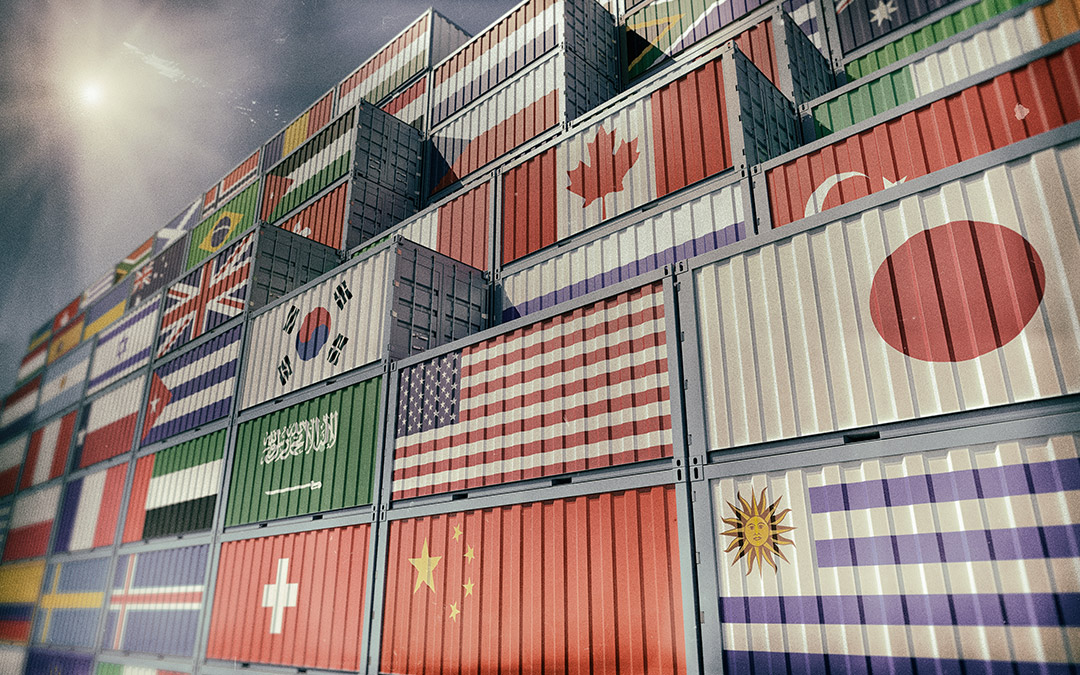
I Contain Multitudes: The Human Side of Financial Planning
April 7, 2025
Market Volatility: The Greatest Victory is to Conquer Yourself
April 11, 2025On Wednesday, April 2nd, President Donald Trump unveiled plans to impose some of the most aggressive tariffs seen since the 1930s. This announcement sent the United States stock market into a state of turmoil. Within two days of the big news, the S&P 500 lost over $5 trillion since its record high, and the Nasdaq officially entered a bear market.
These significant selloffs highlight investors’ growing concerns about the impact of Trump’s tariffs on international trade, inflation, and economic growth. So, what do Trump’s tariffs mean for the stock market and broader economy?
In this article, we’ll break down the specifics of Trump’s latest tariff strategy, examine the rationale behind it, and explore the immediate and long-term effects on the stock market. We’ll also analyze how these tariffs could influence inflation, interest rates, global supply chains, and the growing risk of a recession.
Trump’s April 2nd “Liberation Day” Announcement
On April 2nd, President Trump unveiled a new package of tariffs targeting foreign imports. These tariffs were implemented in two phases:
- On April 5th, Trump enacted a 10% baseline tariff on all imports, which applies to virtually every foreign-made product coming into the U.S., excluding Canada and Mexico. This move dramatically expands the scope of Trump’s aggressive tariff agenda.
- On April 9th, Trump will implement reciprocal tariffs on specific countries, including:
- 46% on Vietnam
- 34% on China
- 32% on Taiwan and Indonesia
- 27% on India
- 25% on South Korea
- 24% on Japan
- 20% on the European Union
These hefty tariffs are designed to mirror these countries’ trade practices. While signing his executive order in the White House Rose Garden, Trump described the current U.S. trade deficits as a “national emergency.” He said, “April 2, 2025, will forever be remembered as the day American industry was reborn, the day America’s destiny was reclaimed, and the day that we began to make America wealthy again.”
President Trump’s Previous Tariff Announcements
This latest announcement isn’t the first in Trump’s tariff strategy. In February 2025, he implemented a 25% tariff on all Mexican and Canadian goods, along with a 10% tariff on Canadian energy imports.
The goal of these tariffs was to motivate the two neighboring countries to address the migration and fentanyl crisis. However, Trump later issued exceptions for Mexican and Canadian goods that comply with the United States-Mexico-Canada Agreement (USMCA).
On February 10th, Trump also implemented a 25% tariff on steel and aluminum, and on March 26th, he enacted a 25% tariff on automobiles and certain foreign-made car parts. He has floated the idea of applying similar tariffs to copper, pharmaceuticals, and semiconductor imports in the near future.
The Rationale Behind the Trump Administration’s Tariff Strategy
Trump’s latest tariffs escalate the ongoing trade war and send uncertainty throughout the American and global economies. While some are cheering these strong measures, his tariff policies have also drawn criticism from several economists, international trade experts, and even some conservative lawmakers.
Despite the backlash, the Trump administration believes other countries have subjected the United States to unfair trade practices, from intellectual property theft to currency manipulation, for far too long. Thus, these tariffs are designed to address historic trade imbalances and generate income for the federal government. Tariffs are a very aggressive and quick tool to use to affect global import and export economies.
On April 5th, Trump shared this message on Truth Social: “China… and many other nations have treated us unsustainably badly. We have been the dumb and helpless “whipping post,” but not any longer. We are bringing back jobs and businesses like never before. Already, more than FIVE TRILLION DOLLARS OF INVESTMENT, and rising fast! THIS IS AN ECONOMIC REVOLUTION, AND WE WILL WIN. HANG TOUGH, it won’t be easy, but the end result will be historic.”
Read More: Donald Trump’s Election Victory: The Stock Market’s Response and Economic Outlook
What Are the Economic Impacts of the New Tariffs?
While Trump has confidence in his tariff strategy, not everyone shares his optimism. Many market analysts warn that these tariffs could have significant economic consequences, particularly in terms of inflation, global supply chains, and the growing risk of a recession.
Let’s take a look at each of these factors in closer detail:
Stock Markets
The U.S. stock market plummeted after Trump’s latest tariff announcement. The S&P 500 lost 6%, closing its worst week since March 2020. Meanwhile, the Dow Jones industrial average plunged 5.5%, and the Nasdaq composite fell 5.8%.
Global stock markets were similarly affected. Chinese equities saw a sharp decline, with the Shanghai Composite losing nearly 3% in a single day. Meanwhile, Canada’s main stock index, the S&P/TSX, plummeted by 1,142 points. These dramatic sell-offs underscore investors’ growing concerns about the potential long-term effects of the tariffs on corporate profitability. After all, tariffs create a wide range of economic pressures, including:
- Elevated input costs, reducing companies’ profit margins.
- Higher prices, as companies pass on their elevated expenses to consumers.
- Lower demand, as consumers cut back on their spending.
- Reduced expansion and investment, due to reduced demand and ongoing economic uncertainty.
According to Goldman Sachs’ Chief U.S. Equity Strategist David Kostin, every five percentage point increase in the U.S. tariff rate could slash S&P 500 earnings per share by 1% to 2%. Meanwhile, market strategist Ed Yardeni reduced his S&P 500 prediction from 6,400 to 6,100 after observing Trump’s willingness to “take a wrecking ball to the economy.” Even so, he still believes a recovery is possible by the end of the year.
Inflation
The new tariffs could add significant inflationary pressure to the U.S. economy, affecting consumer prices across multiple sectors. Pantheon Macroeconomics predicts that the 10% tariff on all imports could increase inflation by approximately 0.8% in 2025.
According to the National Retail Federation (NRF), consumer prices for clothing may rise anywhere from 12.5% to 20.6% in the coming months. Electronics, cars, and machinery may also face notable price increases.
Interest Rates and the Federal Reserve’s Response
Starting in 2022, the Federal Reserve hiked up interest rates to lower record-high inflation. It pivoted its fiscal policy in September 2024, bringing rates down to a range of 4.25% and 4.50%. However, it may need to change course yet again in light of Trump’s inflationary tariff policy.
“We face a highly uncertain outlook with elevated risks of both higher unemployment and higher inflation,” said Federal Reserve Chair Jerome Powell on April 5th. “While tariffs are highly likely to generate at least a temporary rise in inflation, it is also possible that the effects could be more persistent.” Thus, the Fed isn’t rushing to implement additional rate cuts. “We’re going to need to wait and see how this plays out,” explained Powell.
Read More: What You Need to Know About the Fed’s September 2024 Rate Cut
Global Supply Chains
Trump’s tariffs are already sending shock waves through global supply chains. American companies that rely on foreign-made goods are rethinking their supply chains to cope with rising costs.
Meanwhile, many countries are currently developing their countermeasures. The European Union has announced plans to implement retaliatory tariffs. “We are already finalizing the first package of countermeasures in response to tariffs on steel, and we are now preparing for further countermeasures to protect our interests and our businesses if negotiations fail,” said European Commission President Ursula von der Leyen. Meanwhile, Italy’s prime minister Giorgia Meloni expressed an interest in developing a deal with the U.S. to “prevent a trade war.”
China took a more combative approach, announcing that it plans to raise tariffs on all American-made goods by 35% on April 10th. In response, Trump threatened to impose a new 50% tariff on Chinese goods if Beijing doesn’t remove its retaliatory duties by April 8th.
Sector-Specific Impacts
While the broader economy is at risk, some sectors may be more acutely affected by Trump’s tariffs than others. These sectors include:
- Retail Goods – 2025’s cost of living was already challenging for low- and middle-income families. With the real risk of rising prices, these consumers may struggle to afford basic necessities. Thus, retailers relying heavily on imported goods may feel the pinch in their profit margins as they navigate these new pricing dynamics.
- Technology – China is a key manufacturing hub for many tech companies, so its hefty tariffs may significantly strain the technology sector. For example, companies like Apple may soon face higher production costs, which may contribute to increased consumer prices.
- Automotive and Manufacturing – The automotive industry relies heavily on steel, aluminum, and other materials imports. In light of Trump’s tariffs, U.S. automakers may face increased production costs, potentially leading to higher vehicle prices for consumers.
- Banking – Some financial institutions may benefit from rising interest rates related to Trump’s tariffs. However, the possibility of a protracted trade war may also destabilize global financial markets, increasing the risk for financial institutions with notable exposure to international markets.
Potential for a Recession
As companies adjust to higher costs, they may be forced to lay off workers, further dampening consumer demand and contributing to a slowdown in economic activity. Thus, many economists over the last week have been forecasting an increased risk of a recession within the next 12 months.
Just take a look at these predictions:
- Daraius Irani, Chief Economist and Vice President of Towson University’s Strategic Partnerships and Applied Research Office – “Pre-January, the percentage of the probability of recession was somewhere between 10% and 15%. Now, it’s pushed up to 60% to 70%.”
- Kristina Hooper, Chief Global Market Strategist at Invesco – “The risk of recession increases every day that these high tariffs are in force. We anticipate significant volatility and downward pressure on risk assets in the near term. The risk of stagflation in the US has also increased.”
- Michael Feroli, Chief U.S. Economist at JP Morgan Chase – “We now expect real GDP to contract under the weight of the tariffs, and for the full year (4Q/4Q) we now look for real GDP growth of -0.3%, down from 1.3% previously. The forecasted contraction in economic activity is expected to depress hiring and over time to lift the unemployment rate to 5.3%.”
Alden Investment Group: Navigate the Economic Fallout With Confidence
As President Trump’s tariff policy plays out, investors should carefully monitor global trade trends, inflation, interest rates, and corporate earnings. The market response to these actions has been quick and severe. In the short-term, increased volatility may continue with the risk of further losses until there is more clarity on the length, impact and response to these tariffs.
For those with a longer-term investment outlook, this week’s market downturn may be a tempting opportunity to buy undervalued assets. Just keep in mind that significant price swings may continue as foreign countries finalize their retaliatory measures, and at present, there is no clear end to the tariff policy. We remain on the lookout for signals that the market has digested all of the information, risk, and potential opportunity present in these recent developments before advocating a change in investment strategy.
No matter your goals or time horizon, you should discuss your investment strategy with an experienced financial advisor. At Alden Investment Group, our advisors can help you navigate the impacts of Trump’s policies on your portfolio, whether you want to fortify your retirement savings or pursue ambitious growth initiatives. Contact us today to learn more!
Sources:
Business Insider. The last time the US raised tariffs this much it made the Great Depression way worse.
https://www.businessinsider.com/trumps-tariffs-highest-since-the-great-depression-2025-4
Reuters. S&P 500 loses $5 trillion in two days in Trump tariff selloff.
https://www.reuters.com/markets/global-markets-wrapup-1-2025-04-04/
ABC News. Trump rolls out sweeping tariffs as he deems deficits a ‘national emergency’.
https://abcnews.go.com/Politics/trumps-liberation-day-arrives-gambles-big-risky-tariff/story?id=120382209
NPR. Trump unveils sweeping 10% tariff and ‘reciprocal’ tariffs on dozens of nations.
https://www.npr.org/2025/04/02/nx-s1-5345802/trump-tariffs-liberation-day
The White House. Fact Sheet: President Donald J. Trump Imposes Tariffs on Imports from Canada, Mexico and China.
https://www.whitehouse.gov/fact-sheets/2025/02/fact-sheet-president-donald-j-trump-imposes-tariffs-on-imports-from-canada-mexico-and-china/
The White House. Fact Sheet: President Donald J. Trump Restores Section 232 Tariffs.
.https://www.whitehouse.gov/fact-sheets/2025/02/fact-sheet-president-donald-j-trump-restores-section-232-tariffs/
The White House. Fact Sheet: President Donald J. Trump Adjusts Imports of Automobiles and Automobile Parts into the United States.
https://www.whitehouse.gov/fact-sheets/2025/03/fact-sheet-president-donald-j-trump-adjusts-imports-of-automobiles-and-automobile-parts-into-the-united-states/
CBC. Markets plunge worldwide for a second day straight following China’s tariff retaliation.
https://www.cbc.ca/news/business/stock-market-falls-1.7501962
Vox. China’s stock market crash, explained in charts.
https://www.vox.com/2015/7/8/8911519/china-stock-market-charts
Goldman Sachs. How tariffs are forecast to affect US stocks.
https://www.goldmansachs.com/insights/articles/how-tariffs-are-forecast-to-affect-us-stocks
Investors.com. U.S. Vs. World: What Trump Tariffs Mean For The U.S. Economy And Stock Market.
https://www.investors.com/news/trump-tariffs-what-they-mean-us-economy-stock-market/?src=A00444A&refcode=aflGoogleNews
NPR. Here’s what Trump 2.0 means for the economy, from tariffs to mass deportations.
https://www.npr.org/2024/11/06/nx-s1-5181327/trump-election-economy-tariffs-deportations
NBC Los Angeles. Trump’s tariffs could trigger ‘dramatic’ price spikes on clothes, furniture, warns retail group.
https://www.nbclosangeles.com/news/business/money-report/trumps-tariffs-could-trigger-dramatic-price-spikes-on-clothes-furniture-warns-retail-group/3552486/?os=vbkn42tqhoPmKBEXtcfdSuHsoH&ref=app
CNN Business. Jerome Powell warns on Trump’s tariffs: High inflation could be here to stay.
https://www.cnn.com/2025/04/04/economy/jerome-powell-fed-tariffs-jobs/index.html
CNN Business. Europe prepares countermeasures to Trump’s tariffs, calling them a ‘major blow to the world economy’.
https://us.cnn.com/2025/04/03/business/europe-tariffs-us-von-der-leyen-intl-hnk/index.html
BBC. World leaders criticise Trump tariffs as ‘major blow’.
https://www.bbc.com/news/articles/cvgql020y5lo
CNBC. Recession fears grow over Trump tariffs: Live updates.
https://www.cnbc.com/2025/04/07/trump-tariffs-live-updates-stock-market-crypto.html
WBALTV. Economists predict cost-of-living increase of $1,200-$2,000, fear recession.
https://www.wbaltv.com/article/tariffs-cost-of-living-increase-fear-recession-economists-predict/64401019
Invesco. Tariffs and trade wars: What do they mean for investors?
https://www.invesco.com/us/en/insights/tariffs-trade-wars-what-do-they-mean-for-investors.html
Fortune. JPMorgan says Trump’s tariffs to send US into recession.
https://fortune.com/2025/04/05/trump-tariffs-us-recession-outlook-gdp-unemployment-stagflation-inflation-fed/





